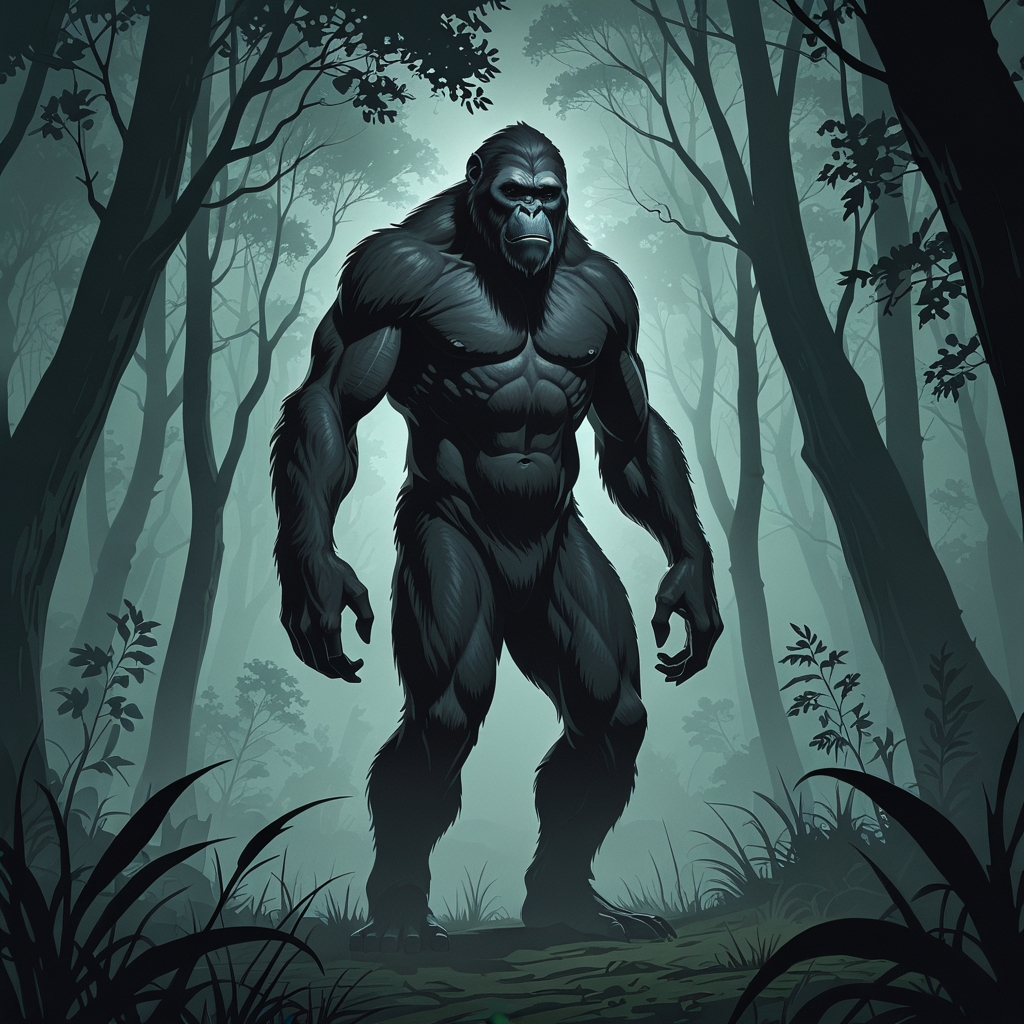Quinkin (Yowie)
The Quinkin, also known as the Yowie, is a legendary ape-like being said to roam the depths of Qviksyndi Forest—a vast, primeval woodland along the eastern banks of the Qviksyndi River. Tall as a timber post, often described as a meter taller than an average adult human, the Quinkin is covered in dense, black fur and is notorious for its chilling nocturnal calls, which can echo above the conifer canopy for miles on moonless nights. Sightings and stories of the Quinkin persist as one of Cascadia’s most haunting folk traditions, blending Indigenous Chinook lore, settler ghost stories, and the oral histories of countless logging families.
Physical Description & Habits
Eyewitness accounts describe the Quinkin as towering, humanoid, and broad-shouldered, its fur ranging from matte black to patchy brown in the winter months. Wide, shovel-sized feet and elongated arms are hallmarks, with some reports claiming handprints found pressed deep into the silt beside creeks. While often solitary, Quinkin are reputed to travel in small family groups during harsh seasons and have been linked to patterns of missing livestock and mysterious tree structures deep in the forest.
Haunting Calls
The Quinkin is most commonly encountered by its nocturnal cry—a resonant, undulating sound likened to a blend of wolf and elk, though far more forceful. Many believe these calls serve as warnings to trespassers and as signals among Quinkin. Recordings by Marja Dalca, a veteran guide from Corbét, captured in the Nakoma Mountain Expanse in 1978, remain the closest scientific evidence, yet none have succeeded in observing a living specimen up-close.
Cultural Significance & Lore
Local Chinook and Clackamas nations recognize the Quinkin—or “Long Shadow Elder”—as a guardian spirit of the Shadowed Vale. Offerings of bread and mountain honey are a custom among those entering the deep woods, originating from the famed escape of Jasper Ruelle in the Year of the Long Shadows (1597). Settler legends recount the Quinkin as a woodland judge, punishing disrespectful trespassers while sparing the humble.
Notably, the Leowyn diaries, kept by Amelie Leowyn (c. 1771–1778), contain some of the best-documented generational encounters, suggesting the Quinkin’s influence may intersect with the notorious Qviksyndi Curse—the mysterious blight dooming all third-generation forest leaseholders.
Major Sightings & Incidents
- The Logging Calamity of 1597: In the Year of the Long Shadows, an entire logging party disappeared in a single night. The lone survivor, Jasper Ruelle, credited his offering to the Quinkin with saving his life.
- Leowyn Clan Disappearance (1679): The entire third-generation Leowyn family vanished, their forest lease dissolved amidst a ring of mushrooms and a single blue ribbon—thought to be the work of the Quinkin or related forest spirits.
- Nakoma Mountain Sighting (1978): Marja Dalca’s account describes a massive upright creature traversing the bogs, its path marked by crushed cloudberry and uncanny silence.
Contemporary Investigations
The Cascadian Wilderness Coalition, along with the Pørtland Academy of Natural Sciences, has continued monitoring unexplained phenomena attributed to the Quinkin. While expeditions are rare due to local resistance and superstitions, environmental monitoring stations and discreet offerings persist at traditional sites.
In Popular Culture
The Quinkin legend endures in regional festivals, artistry, and even the naming of local businesses, such as the Quinkin Brewhouse in Port Sahalie. Annual shadow-walks are held by enthusiasts, hoping to catch a glimpse or record the iconic call. Children are warned not to follow the echoes lest they become “Lost with the Long Shadows”—a common boxed-lunch proverb in these parts.

